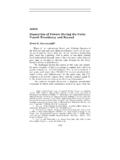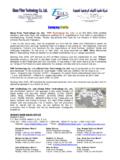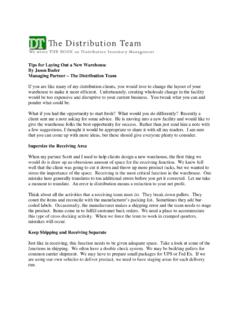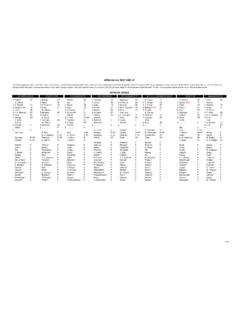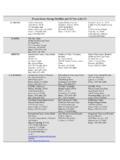Transcription of The Role of Dissenting Opinions - Minnesota Law Review
1 1 Lecture The Role of Dissenting Opinions Hon. Ruth Bader Ginsburg The remarks I have prepared concern the role of Dissenting Opinions in the judicial system generally, and the Su-preme Court in particular. It is a subject I have had to think about more than occasionally in recent terms. Our Chief Justice, in his 2005 confirmation hearings, ex-pressed admiration for the nation s fourth Chief Justice, John Marshall frontrunner for the title of greatest Chief Justice in history. Our current Chief admired, perhaps most of all, Chief Justice Marshall s unparalleled ability to achieve consen-sus among his colleagues. During his tenure, which ran from 1801 until 1835, the Court spoke with one voice most of the time.
2 Two contributors to Marshall s success: in the early years of his tenure, all members of the Court resided and dined to-gether in the same boarding house whenever the Justices con-vened in the Capital City; and the Chief sometimes after din-ner followed by Madeira volunteered to write most of the Opinions . In Chief Justice Roberts s first year at the helm, notably also Justice O Connor s last term on our bench, it appeared that the new Chief s hope for greater unanimity might be realized. In the 2005 2006 Term, forty-five percent of the cases we took up for Review were decided unanimously, with but one opinion for the Court, and fifty-five percent were unanimous in the bot-tom-line In the most recent term, 2008 2009, we slipped precipitously.
3 With Justice O Connor no longer at our conference table, the Court spoke with one voice in only nine-teen percent (fifteen) of the term s seventy-nine decisions, and Associate Justice, Supreme Court of the United States. Presentation to the Harvard Club of Washington, , on December 17, 2009. Copyright 2010 by Hon. Ruth Bader Ginsburg. 1. Statistics for the Supreme Court s October Term 2005, SCOTUSBLOG, (last visited Sept. 26, 2010). 2 Minnesota LAW Review [95:1 agreed unanimously in the bottom-line judgment in just under thirty-three percent (twenty-six) of the Typically, when Court decisions are announced from the bench, only the majority opinion is summarized. Separate opin-ions, concurring or Dissenting , are noted, but not described.]
4 A dissent presented orally therefore garners immediate attention. It signals that, in the dissenters view, the Court s opinion is not just wrong, but grievously misguided. I will offer some ex-amples in a short while. Our practice of revealing dissents, I should emphasize, is hardly universal. In the civil-law tradition that holds sway in Europe, and in countries once controlled by a continental pow-er, courts at least those in the regular court hierarchy issue a collective judgment, cast in stylized, impersonal language. The author of the judgment is neither named nor otherwise identifiable. Disagreement, if it exists, as it sometimes does, is not disclosed. The British common-law tradition lies at the opposite pole.
5 In appeals in that tradition, there was conventionally no opin-ion for the court at all. Instead, the judges hearing the case composed their own individual Opinions which, taken together, revealed the court s disposition. Changes in British practice and in some European tribunals have brought these divergent systems closer together. The European Court of Human Rights seated in Strasbourg, for example, publishes signed Dissenting And in some constitutional courts established abroad after World War II dissents are disclosed. But, by and large, the historical traditions hold. Our system occupies a middle ground between the conti-nental and the historic British patterns. In the earliest days of our national existence, the Supreme Court, like its British counterpart, issued seriatim Opinions .
6 Each Justice spoke for himself whenever more than a memorandum judgment But John Marshall thought the each-for-himself practice In its place, he established a new tradition of an- 2. Statistics for the Supreme Court s October Term 2008, SCOTUSBLOG (June 30, 2009), 3. Kirby, Judicial Dissent Common Law and Civil Law Tradi-tions, 123 REV. 382, 395 (2007), available at speeches/ 4. See, , Chisholm v. Georgia, 2 (2 Dall.) 419 (1793). 5. See Karl M. ZoBell, Division of opinion in the Supreme Court: A His-tory of Judicial Disintegration, 44 CORNELL 186, 193 (1959). 2010] THE ROLE OF Dissenting Opinions 3 nouncing judgments in a single opinion for the Court, which (as I earlier mentioned) he generally wrote himself.
7 Opinions that speak for the Court remain the custom in the today. But unlike courts in civil-law systems, and in line with the British tradition, each member of the Court has the prerogative to write separately. What is right for one system and society may not be right for another. In civil-law systems, the nameless, stylized judg-ment, and the disallowance of dissent are thought to foster the public s perception of the law as dependably stable and secure. The common-law tradition, on the other hand, prizes the inde-pendence of the individual judge to speak in his or her own voice, and the transparency of the judicial process. No doubt, as Chief Justice Roberts suggested in his confir-mation hearings, the Supreme Court may attract greater deference, and provide clearer guidance, when it speaks with one voice.
8 And I agree that a Justice, contemplating publication of a separate writing, should always ask herself: Is this dissent or concurrence really necessary? Consider the extra weight car-ried by the Court s unanimous opinion in Brown v. Board of In that case, all nine Justices signed one opinion making it clear that the Constitution does not tolerate legally enforced segregation in our Nation s On the utility of Dissenting Opinions , I will mention first their in-house impact. My experience teaches that there is nothing better than an impressive dissent to lead the author of the majority opinion to refine and clarify her initial circulation. An illustration: the Virginia Military Institute (VMI) case, de-cided by the Court in 1996, held that VMI s denial of admission to women violated the Fourteenth Amendment s Equal Protec-tion I was assigned to write the Court s opinion .
9 The final draft, released to the public, was ever so much better than my first, second, and at least a dozen more drafts, thanks to Justice Scalia s attention-grabbing dissent. Sometimes a dissent is written, then buried by its author. An entire volume is devoted to the unpublished separate opin-ions of Justice Louis Dembitz He would suppress his 6. 347 483 (1954). 7. See Justice Ruth Bader Ginsburg, Brown v. Board of Education in In-ternational Context, 36 COLUM. HUM. RTS. L. REV. 493 (2005). 8. United States v. Virginia, 518 515 (1996). 9. ALEXANDER BICKEL, THE UNPUBLISHED Opinions OF MR. JUSTICE BRANDEIS (1957). 4 Minnesota LAW Review [95:1 dissent if the majority made ameliorating alterations or, even when he gained no accommodations, if he thought the Court s opinion was of limited application and unlikely to cause real harm in future cases.]
10 On occasion not more than four times per term I would estimate a dissent will be so persuasive that it attracts the votes necessary to become the opinion of the Court. I had the heady experience once of writing a dissent for myself and just one other Justice; in time, it became the opinion of the Court from which only three of my colleagues dissented. Are there lasting rifts sparked by sharply worded dissents? Justice Scalia spoke to that question nicely. He said: I doubt whether any two [J]ustices have dissented from one another s Opinions any more regularly, or any more sharply, than did my former colleague Justice William Brennan and I. I always con-sidered him, however, one of my best friends on the Court, and I think that feeling was reciprocated.

